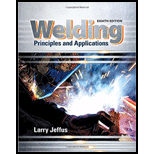
Bundle: Welding: Principles and Applications, 8th + MindTap Welding, 4 terms (24 months) Printed Access Card
8th Edition
ISBN: 9781337219426
Author: Larry Jeffus
Publisher: Cengage Learning
expand_more
expand_more
format_list_bulleted
Textbook Question
Chapter 5, Problem 5R
What are the advantages of welded piping systems over other joining methods?
Expert Solution & Answer
Trending nowThis is a popular solution!

Students have asked these similar questions
I need solutions to this questions
Don't use Artificial intelligence
Please consider the following closed-loop Multiple-Input Multiple-Output (MIMO) control system:
R₁(s) and R2(s) are the reference signals (or inputs),
•
G₁(s) (where i = 1,2,3,4,5) are the plant transfer functions,
•
C₁(s) and C2(s) are the responses (or system outputs),
•
All of them are in Laplace domain.
R2
+
R₁ +
+
G₂(s)
G3(S)
Tasks:
G5(s)
G4(s)
+
G₁(s)
می
a) Please derive the transfer function between C₁ (s) and R₂(s) (i.e., find
R₂(s)
(10 marks)
(10 marks)
b) Please derive the transfer function between C₂(s) and R₁(s) (i.e., find C2 (s)).
R₁(s)
Hint: Please carefully analyse how the signals interact with the plants G₁(s) and find all paths from
Một thanh dài L = 2,5 m được nối bằng chốt với một con lăn ở A. Con
lăn chuyển động dọc theo một đường ray nằm ngang như hình vẽ với
VA 5 m/s. Xác định vận tốc của điểm C (trung điểm của thanh AB)
=
tại thời điểm 0 = 33° và O = 0.4 rad/s.
A. v = (-5.42+0.272})(m/s)
C. v = (5.421+0.272})(m/s)
B. v =(0.272i+5.42j)(ms)
D. (5.42-0.272)(m/s)
=
C
B
Chapter 5 Solutions
Bundle: Welding: Principles and Applications, 8th + MindTap Welding, 4 terms (24 months) Printed Access Card
Ch. 5 - List some applications that use low-pressure...Ch. 5 - List some applications that use medium-pressure...Ch. 5 - List some applications that use high-pressure...Ch. 5 - Describe the differences between pipe and tubing.Ch. 5 - What are the advantages of welded piping systems...Ch. 5 - Why must the ends of pipe be beveled before being...Ch. 5 - How can the ends of a pipe be beveled?Ch. 5 - Why is the end of a pipe beveled at a 371/2 angle?Ch. 5 - What causes root suck-back or a concave root face?Ch. 5 - Why are arc strikes outside the welding zone...
Ch. 5 - What are the purposes of backing rings?Ch. 5 - What is the purpose of a hot pass?Ch. 5 - Why must the weld crater be cleaned before...Ch. 5 - What is the maximum width of the cover pass? Why?Ch. 5 - When is the 1G welding position used?Ch. 5 - What can make welding in the 2G vertical fixed...Ch. 5 - What supports the welds on a 2G pipe joint?Ch. 5 - On 5G welds, what usually determines the direction...Ch. 5 - What angle is the pipe at in the 6G position?Ch. 5 - In addition to continuously changing the weld...
Knowledge Booster
Learn more about
Need a deep-dive on the concept behind this application? Look no further. Learn more about this topic, mechanical-engineering and related others by exploring similar questions and additional content below.Similar questions
- The simulink and Matlab part are the prioritized areas please.arrow_forwardPlease do not rely too much on chatgpt, because its answer may be wrong. Please consider it carefully and give your own answer. You can borrow ideas from gpt, but please do not believe its answer.Very very grateful! Please do not copy other's work,i will be very very grateful!!arrow_forwardAn industrial burner uses natural gas as fuel. The natural gas consists primarily of CH4 with small quantities of several other light hydrocarbons and can be represented as C1.16H4.32 To achieve low emissions of oxides of nitrogen, the burner operates lean at equivalence ratio of 0.4. Assume complete combustion and answer the following questions. i) What is the operating air-fuel ratio (i.e. mass air/mass of fuel)? [6 marks] ii) What is the percent excess air in the combustion products? [3 marks] iii) What is the oxygen (O2) mole fraction in the combustion products? [6 marks]arrow_forward
- 1) Consider the robot, with six degrees of freedom, RRPRR, shown in the following figure.Place the axes through the denavit-hartenberg algorithm and obtain the respective parameter table for the first three joints. 2) Considering the robot from question 1, calculate.the. Determine the Homogeneous Transformation Matrix in relation to the Direct Kinematics of the robot, for the first three joints:b. Considering the first three joints of the robot and L1 and L2 equal to 200 mm:I. calculate the pose of the robot relative to the base, knowing the joint variableshave the following values: q1= 90°, q2= 0°, q3= 50mm:arrow_forwardPlease do not rely too much on chatgpt, because its answer may be wrong. Please consider it carefully and give your own answer. You can borrow ideas from gpt, but please do not believe its answer.Very very grateful! Please do not copy other's work,i will be very very grateful!!arrow_forwardDon't use Artificial intelligencearrow_forward
- Solve this problem and show all of the workarrow_forwardI need to calculate Fdy, Fby, Fbxarrow_forwardFigure 3 shows the numerical solution of the advection equation for a scalar u along x at three consecutive timesteps. 1.0- 0.8- 0.6- 0.4- 0.2 0.0- -0.2- -0.4- -0.6 T T T 3.0 3.5 4.0 4.5 5.0 5.5 6.0 6.5 Figure 3: Advection equation, solution for three different timesteps. a) Provide an explanation what conditions and numerical setup could explain the curves. Identify which of the three curves is the first, second and third timestep.arrow_forward
arrow_back_ios
SEE MORE QUESTIONS
arrow_forward_ios
Recommended textbooks for you
 Welding: Principles and Applications (MindTap Cou...Mechanical EngineeringISBN:9781305494695Author:Larry JeffusPublisher:Cengage Learning
Welding: Principles and Applications (MindTap Cou...Mechanical EngineeringISBN:9781305494695Author:Larry JeffusPublisher:Cengage Learning

Welding: Principles and Applications (MindTap Cou...
Mechanical Engineering
ISBN:9781305494695
Author:Larry Jeffus
Publisher:Cengage Learning
Differences between Temporary Joining and Permanent Joining.; Author: Academic Gain Tutorials;https://www.youtube.com/watch?v=PTr8QZhgXyg;License: Standard Youtube License